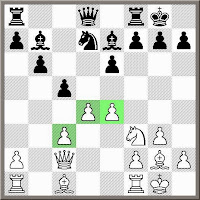Today I will show you two games from my last tournament, and one of those games is analysed, while the second game is of high complexity so I decided that it can be too much for this blog, so I took only two positions from the game that illustrates the thinking process during the game.
The both games are played against Bosnian FIDE Masters, and in one of the games, while everything went smooth, I can be very satisfied with my decisions. These maybe can be a school examples of the play in given opening, but a play after 1.d4 from the White´s stand point is not my strongest side.
This concept of publishing games with the most critical moments, which are given to readers to think on their own, proved to be very popular.
Of course, the solutions can be found in the game commentary.
This time, directly to the position from the introduction.
This type od centre is typical for Grunfeld Indian Defence, or Semi-Tarrasch Queen´s gambit.
The difference here is that White´s bishop is in fianchetto.
It means that it will not be quick attack on the Black king.
Later, you can see what I played in the game, but for now you can think on your own.
Black´s idea is cxd4 and then Rc8, when Only Black can be better.
My solution is typical for this structure, but please, do not forget that my bishop is on g2, and even if my move was typical, the ideas that covers it tactically are atypical for this kind of positions.
This is one of the positions which I want to share with you.
The task here is to try to estimate how big are White´s winning chances.
We never reached this position in the game, but it was possible to enter it more or less in a forcing line.
Black is on move, even if that is not the most important thing in this position (we have long term positional factors that can not be changed by concrete variations in this position).
For the better understanding of these positions, I can recommend you to read the book from Michail Marin, Learn from the legends, the chapter about Alekhine.
The final combination of this game can be found in article about monthly combinations here .
Now, we can see the other game.
I was Black, and I played for a win.
In this position I could defend with 12...Be6 with equality.
For example:
13. Bf5, 0-0 14. Bxe6, fxe6 15. Rxe6, Bxc3 16. bxc3, Rxf2!
17. Kxf2, Qf7+ 18. Qf3, Qxe6 Black is nicer, but the position is of course draw.
I played:
12...Kf8!?
Because of my superiority on the dark squares I thought that it will be easy to finish my development, and that later on in the game I can make something from my bishop par, slightly better control in the centre and open b-file.
However, White managed to keep his initiative alive for some time, finding the tactical solutions all the time.
Some of those can be found in article about September combinations here .
We reached this position, and in this position I found quite a strong solution, yet completely unexpected:
15...Ke7!!
Yes, I am going with my king toward the centre.
All this in order to activate the rook on h8.
Do not try this at home!
As analyse proves, there are no continuations that can exploit the centralised position of my king.
The thing is that even I underestimated my position and couple of moves later defended my strong/weak point on e6.
16. Bf5, Rhe8
17. Qh3
It could be the complete surprise if I played:
17...Kf8!
Which I missed, so the game eventually ended in a draw.
It was a long fight but neither side managed to break the balance.






No comments:
Post a Comment